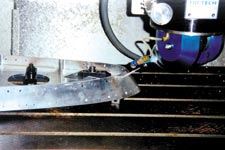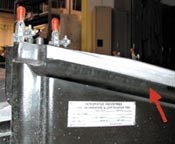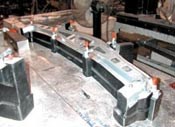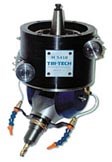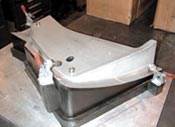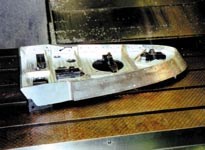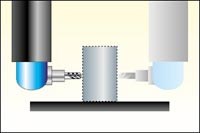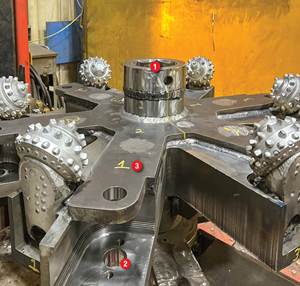Five-Axis Machining With A Contouring Head
This accessory brought low-cost five-axis machining to two shops. One had never used five-axis machining before. The other was an experienced five-axis contractor.
Share





Traditionally, five-axis machining has been used only by shops machining parts from an exclusive list. Aerospace parts, power generation components, and some varieties of tooling have all made good five-axis candidates, but not much else. And that’s still the case today. However, an important trend in five-axis machining is that the technology is becoming cheaper and easier to use. As a result, the exclusivity of five-axis machining may be just about to give way. Easier access to this technology—combined with the efficiencies that rotary axes can bring even to simple parts—may result in five-axis machining being adopted by shops in a great many industries, instead of just a few.
We’re not there yet. However, the kinds of technologies that may bring about a more wide-spread use of five-axis machining have started to appear. This article focuses on just one of those technologies, an add-on five-axis head. Affixing this head to the spindle of a conventional three-axis vertical machining center can add two CNC rotary axes to that machine, making the machine capable of not only reorienting the tool, but also feeding the tool in coordinated rotary motion for complex five-axis cuts.
Two shops using add-on five-axis heads manufactured by Tri-Tech Precision Products (Anaheim, California) serve to illustrate the role this accessory can play. By some measures—rigidity, for one—the head is more limited than many machining centers designed and built for five-axis work. However, a conventional machining center equipped with one of these heads is also less expensive than the full five-axis machine. In the cases of both shops discussed in this article, the head lets them apply five-axis machining to work that would not be economical to run on traditional, more expensive five-axis machine tools.
These shops do make the kinds of parts for which five-axis machining is often used. One is an aerospace contractor that has long done five-axis work.
However, the other shop—a maker of dies and fixtures—purchased the head accessory so it could venture into five-axis machining for the first time.
Contoured Tooling
Integrated Industries (Clinton Township, Michigan) is a manufacturer of forming dies for short-run automotive sheet metal parts. The company makes dies that automakers use to produce small quantities of prototype parts. Along the way, the shop also uses the customer-supplied CAD geometry to produce the “check fixtures” used to hold these sheet metal parts during inspection. This is where five-axis machining comes in.
The sheet metal part lays on top of a check fixture, which conforms to the part’s geometry exactly. The fixtures are made from an aluminum-filled epoxy. The shop machines a rough cavity in foam, then pours the liquid epoxy inside. When the epoxy hardens, the foam is broken away, and the resulting solid is finish-machined to the fixture’s intended form.
Last year, a new requirement from General Motors took effect saying that check fixtures had to allow not only the form of the part to be checked, but also the extent of its trim. The edges of new check fixtures would have to be such that they allowed the reach of the metal part’s edges to be gauged. And because these fixtures themselves have to be qualified by CMM inspection, the undercuts below these edges everywhere had to be normal to the fixture’s surface.
The photograph of a fixture on page 98 may help you to visualize this. Even if it doesn’t, don’t worry. Here is the relevant fact: Because of the new requirement, the epoxy fixtures now feature complex contoured undercuts, and essentially the only way to machine these undercuts is through five-axis milling.
Meeting this requirement was the main reason to obtain five-axis capability. However, once the shop had this capability in place, it found other benefits that applied not only to the undercuts, but also to other features of the fixtures. They include:
- Shorter tools. The freedom to reorient the tool in the rotary axes lets the shop use shorter tools to reach difficult-to-access features of the workpiece. Shorter tools produce a more accurate part by reducing the magnitude of tool deflection error.
- Fewer setups. The contouring head has a 360-degree range of motion. This means the shop can mill complex features in opposite sides of the same workpiece in a single cycle. The operator doesn’t have to perform an additional setup just to reorient the part.
In the search for the right five-axis equipment, Integrated Industries president Paul Newman didn’t start with the contouring head. When first alerted to GM’s new requirement, he set out to look for a five-axis machine tool. However, price was a barrier. Standard five-axis machining centers come in two types, he says—lighter machines with small travels or machines that are both larger and more robust. Neither type fit his requirements. He needed to machine workpieces roughly the size of an automotive sheet metal part, but cut in epoxy or foam. In other words, he needed the size, but not the robustness, and he could not justify paying for both. He bought the contouring head as an alternative.
The head was first mounted on one of the shop’s existing vertical machining centers. However, this necessitated another expense. That machine’s CNC was capable of controlling five axes, but only at lower speeds. It was not capable of moving five axes at 700 ipm, the feed rate the shop sometimes uses to mill foam. To realize the high feed rate, the shop bought a faster CNC from Numatix (Farmington Hills, Michigan). Technicians from both this company and the company supplying the head worked together to install the combination.
Mr. Newman stresses that the CNC and contouring head together resulted in a combined investment of about $100,000. Not all shops will have to buy a new CNC to apply the head to one of their existing machines . . . and even when they do, the total cost can still be a relatively low one to get into five-axis machining. However, in cases where additional expenses are necessary, “low cost” is not quite synonymous with cheap.
In addition, because the shop had never performed five-axis machining before, it also needed CAM software that could program five-axis cuts. The shop’s preferred CAM system could program cuts in which the tool had been reoriented in a rotary axis, but it was not capable of defining interpolated five-axis motion.
After looking at several CAM systems, Mr. Newman concluded that “when it comes to five-axis software, there is no perfect product.” The most seamless and effective system he found would itself have cost $100,000—far more than he was willing to spend. The system he chose cost less than $20,000, but this system generally is not as easy to use as the more expensive system would have been when it comes to the most complex parts. As a result, the shop often creates two programs for the same part using two different systems. The three-axis software is used to define tool paths for as much of the model as possible. Then, the programmer creates a separate, subsequent program in the newer software, just for those features that demand five-axis work. In general, these features consist of only the contoured undercut surfaces, plus any off-angle holes.
Ultimately, Integrated Industries’ success with the contouring head was such that the shop decided to buy a new machine to use it. The limiting factor of the existing vertical machining center was its travels. Just the space required for a pivoting head to pivot can use up a significant amount of travel. (See illustration, below) As a result, the machine that uses this head must have travels significantly larger than the dimensions of any workpiece it will machine completely.
Therefore, to make it possible to apply five-axis machining to larger workpieces, the shop purchased a larger, bridge-type vertical machining center from Mighty USA (Torrance, California)—the machine that now uses the head. This larger machine has X-Y travels of 83 by 47 inches.
Even so, one consequence of having first used the head on the smaller machine is that the connections are all still in place. This means the head is now interchangeable between the two machines. Removing the head from one machine and setting it up on the other—including indicating it into position—takes no more than about three hours, Mr. Newman says.
Aircraft Parts
In the case of the other shop—Wilson Products of Auburn, Washington—limited travels were the reason why the shop turned to the contouring head in the first place. This shop is an aerospace and defense contractor and a first-tier supplier to Boeing. An experienced five-axis contractor, the shop has seven five-axis machining centers. However, all but one of these machines feature a “fan-saddle” configuration for the rotary axes. This design, which is familiar to any five-axis aerospace shop, generally limits the travels in each rotary axis to no more than ±30 degrees. By contrast, the contouring head has a range of motion of 180 degrees in the A axis and 360 degrees in C.
The shop now uses contouring heads on two standard vertical machining centers. Both machines came from Fadal Machining Centers (Chatsworth, California). The newer of these two machines was purchased from the builder with the head installed as part of a complete package.
Like Integrated Industries, Wilson Products also purchased the contouring head in response to changing customer requirements. Aircraft components machined by this shop feature compound-angle holes that used to be drilled during assembly. However, as a part of the move toward more monolithic construction of aircraft parts, responsibility for adding holes like these has shifted to the machine shop. The components affected include many smaller parts that formerly required no five-axis work, but were instead machined entirely on horizontal machining centers. For these parts, drilling all of the holes on fan-saddle five-axis machines would require numerous elaborate setups using sine plates. It would also force the shop to commit time on expensive machines to small and relatively inexpensive parts. The contouring heads provide a lower-cost alternative—and one that lets the shop drill all of the holes in most workpieces in no more than two setups.
The bulk of the machining for these parts is still performed on the horizontal machining centers. In fact, the first solution that Wilson Products president Don Myers explored was to add compound rotary tables to these machines. Doing so would avoid the need to relocate each part to a different machine for drilling. However, “adding the compound table ate up too much of the daylight of the machine,” he says. On a machining center with a work cube 40 inches on a side, the shop didn’t have the travels to spare.
So the parts now go to the vertical machining centers for the drilling work. X-Y travels of 60 by 30 inches are generally sufficient to let the contouring head get all the way around the part in one cycle.
In addition, the shop does sometimes perform five-axis milling with the head. However, it only does this on surfaces difficult for the horizontal machining centers to reach, and only in aluminum. The head’s rigidity is limited, Mr. Myers stresses. In stainless, titanium, and Inconel, the shop restricts the head to hole making. As a result, “90 percent of the work we do with the heads is drilling,” he says.
In other words, the head is inexpensive enough that it’s not necessary to perform complex contour milling work to justify it. Wilson Products, an experienced five-axis shop, uses this head the way a shop that has never performed five-axis machining before might use it—to reorient the tool outside the cut, allowing simple machining operations at numerous tool orientations to be performed with just one setup. Some call this type of work “three-two” machining, because the two rotary axes are used only for indexing. A three-axis shop could justify the contouring head just for this type of work . . . and at the same time, set itself up to take on more sophisticated five-axis jobs in the future.
Related Content
DN Solutions America Unveils Impressive Chicago Technical Center at IMTS 2024
New tech center is serving as a cutting-edge showroom and a technological hub for advanced machining applications.
Read MoreThe Cut Scene: The Finer Details of Large-Format Machining
Small details and features can have an outsized impact on large parts, such as Barbco’s collapsible utility drill head.
Read MoreThe Benefits of In-House Toolmaking
The addition of two larger gantry routers has enabled a maker of rubber belting products to produce more tooling in-house, reducing lead times and costs for itself and its sister facilities.
Read MoreHow a Custom ERP System Drives Automation in Large-Format Machining
Part of Major Tool’s 52,000 square-foot building expansion includes the installation of this new Waldrich Coburg Taurus 30 vertical machining center.
Read MoreRead Next
Four Types Of Five-Axis Machining Centers
Different machines offer different approaches to rotary travel, and each design has its own strengths. Here's how they compare.
Read More5 Rules of Thumb for Buying CNC Machine Tools
Use these tips to carefully plan your machine tool purchases and to avoid regretting your decision later.
Read MoreRegistration Now Open for the Precision Machining Technology Show (PMTS) 2025
The precision machining industry’s premier event returns to Cleveland, OH, April 1-3.
Read More












